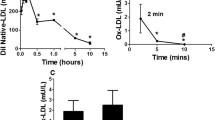Abstract
Purpose. The aim of this study is to investigate the plasma protein binding of nicanartine and to measure its antioxidant effect on lipoproteins.
Methods. The blood binding was studied with an erythrocyte partitioning method and the lipoprotein oxidation with the conjugated dienes method.
Results. Nicanartine was 24.7% LDL (low density lipoprotein)-bound and 29.2% AAG (alphal-acid glycoprotein)-bound. Nicanartine delayed but did not stop the oxidation of the three density classes of lipoprotein HDL (high density lipoprotein), LDL, VLDL (very low density lipoprotein). The addition of AAG to LDL in the conjugated dienes method decreased the nicanartine fraction bound to LDL and decreased its antioxidant effect. The decrease of nicanartine LDL-bound fraction and the decrease in antioxidant effect were not parallel.
Conclusions. This suggested that (a) AAG-bound nicanartine dissociated to equilibrate the decrease in LDL-bound nicanartine consummed by oxidation, or (b) the oxidation conditions could involve chemical modifications of nicanartine and therefore modify its affinity for AAG.
Similar content being viewed by others
REFERENCES
T. Henriksen, E. M. Mahoney, and D. Steinberg. Enhanced macrophage degradation of low density lipoprotein previously incubated with cultured endothelial cells: Recognition by receptors for acetylated low density lipoproteins. Proc. Nat. Acad. Sci. USA. 78:6499–6503 (1981).
U. P. Steinbrecher, S. Parthasarathy, D. S. Leake, J. L. Witztum, and D. Steinberg. Modification of low density lipoprotein by endothelial cells involves lipid peroxidation and degradation of low density lipoprotein phospholipids. Proc. Nat. Acad. Sci. USA. 81:3883–3887 (1984).
J. T. Salonen, S. Yla-Herttuala, R. Yamamoto, and al. Autoantibody against oxidised LDL and progression of carotid atherosclerosis. Lancet 339:883–887 (1992).
M. K. Cathcart, D. W. Morel, G. M. Chisolm. Monocytes and neutrophils oxidize low density lipoprotein making it cytotoxic. J. Leukocyte Biol. 38:341–350 (1985).
M. T. Quinn, S. Parthasarathy, L. G. Fong, D. Steinberg. Oxidatively modified low density lipoproteins: A potential role in recruitment and retention of monocyte/macrophages during atherogenesis. Proc. Nat. Acad. Sci. USA. 84:2995–2998 (1987).
P. Wülfroth, A. Bartmann, C. C. Hopstock, and J. E. Reichel. The new antioxidant Mrz 3/124 improves lipid status and prevents oxidative injury to endothelial cells and macrophages. Bulletin of molecular biology in medicine (in press).
R. J. Havel, H. A. Eder, and J. M. Bragdon. The distribution and chemical composition of ultracentrifugally separated lipoprotein in human serum. J. Clin. Invest. 34:1345–1354 (1955).
H. Esterbauer, G. Striegl, H. Puhl, and M. Rotheneder. Continuous monitoring of in vitro oxidation of human low-density lipoprotein. Free Radic. Res. Commun. 6:67–75 (1989).
S. Urien, G. Bastian, C. Lucas, J. P. Bizzari, and J. P. Tillement. Binding of a new vinca alkaloid derivative, S 12363, to human plasma proteins and platelets. Usefulness of an erythrocyte partioning technique. Investigational New Drugs 10:263–268 (1992).
S. Urien, P. Claudepierre, J. Meyer, R. Brandt, J. P. Tillement. Comparative binding of etretinate and acitretin to plasma proteins and erythrocytes. Biochem. Pharmacol. 44:1891–1893 (1992).
S. Urien, P. Riant, A. Renouard, A. Coulomb, I. Rocher, J. P. Tillement. Binding of indapamide to serum proteins and erythrocytes. Biochem Pharmacol. 37:2963–2966 (1988).
L. R. Mc Lean, K. A. Hagaman. Effect of Probucol on the physical properties of low-density lipoproteins oxidized by copper. Biochemistry. 28:321–327 (1989).
E. Lupo, R. Locher, B. Weisser, and W. Vetter. In vitro antioxidant activity of calcium antagonists against low-density lipoprotein oxidation compared with alphatocopherol. Biochem. and Biophys. Res. Commun. 203:1803–1808 (1994).
V. W. Bowry, K. K. Stanley, and R. Stocker. High density lipoprotein is the major carrier of lipid hydroperoxides in human blood plasma from fasting donors. Proc. Nat. Acad. Sci. USA. 89:10316–10320 (1992).
Author information
Authors and Affiliations
Rights and permissions
About this article
Cite this article
Dailly, E., Urien, S., Wülfroth, P. et al. Nicanartine Improves in Vitro Resistance of Lipoproteins to Oxidation. Pharm Res 13, 457–461 (1996). https://doi.org/10.1023/A:1016013130445
Issue Date:
DOI: https://doi.org/10.1023/A:1016013130445




